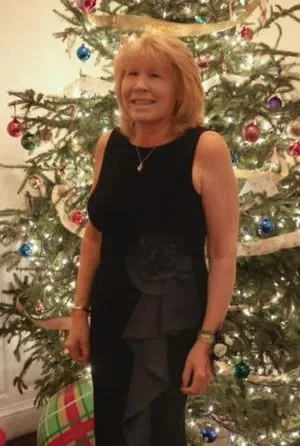Thinking About CAR T? Read This Survivor's Inspiring Story.

CAR T cell therapy offered Lisa a ray of hope after two failed treatments for non-Hodgkin lymphoma. Now she shares her story to spread hope to others.
Some people [go] down this road of ‘What if this?’ and ‘What if that?’ You just have to stay true to your path and just keep marching. Keep going forward.
CAR T cell therapy (CAR T) is a type of immunotherapy treatment that, like other immunotherapies, works with the body’s immune system to find, attack, and kill cancer cells. CAR T is an approved treatment option for a variety of blood cancers, including certain types of lymphoma. Typically, it’s reserved for patients with cancer that is refractory or relapsed after having one or more prior treatments.
The U.S. Food and Drug Administration approved the first CAR T cell therapy in 2017. So, even just a few years ago, when Lisa completed cancer treatment, CAR T was still relatively new. To date, the FDA has approved 6 CAR T cell therapies.
Here’s Lisa’s story:
Four years ago, when Lisa learned she had non-Hodgkin lymphoma, the news was completely unexpected. She’d been having ongoing stomach issues, but she thought an ulcer was the likely culprit. Lisa, a youth music director, was managing her teaching schedule amid the challenges of the COVID-19 pandemic. Meanwhile, two of her adult children were planning their upcoming weddings. “So, there was a lot on the plate,” Lisa says.
A cancer diagnosis was not on anyone’s radar.
“My husband is an ER doc. My son's an ER doc. My son-in-law is an ortho surgeon and my brother-in-law is [in] family practice, so I had a lot of eyes on me thinking that I had something going on, but nothing bad, right?”
Antacids did not relieve Lisa’s symptoms. Over time, the symptoms only seemed to get worse. After an especially intense day of symptoms, Lisa made a doctor’s appointment. Multiple tests were ordered. A PET scan revealed an 11-centimeter mass pushing into her stomach. “It was entangled in all my major organs,” Lisa says.
A biopsy confirmed her diagnosis: advanced non-Hodgkin lymphoma. “It was really bad — double expressor, stage 4, throughout the whole body,” says Lisa.
Two Failed Treatments, Then a Ray of Hope
Lisa’s treatment started promptly at a nearby cancer center. The first line of treatment: a chemotherapy regimen called R-CHOP, often used to treat aggressive lymphomas. As Lisa underwent treatment, she was determined to attend both of her children’s weddings in the months ahead — and she did. R-CHOP, followed by a challenging radiation therapy regimen, couldn’t keep her away from these special life events.
“I had this mental attitude of go, go, go,” says Lisa.
Unfortunately, both treatments failed. A post-treatment scan showed that Lisa’s cancer was still there. At that point, she knew CAR T cell therapy may be the next option. Lisa met the conditions required to enter her cancer center’s CAR T program. One key prerequisite: Having completed two failed cancer treatments.
There were other important conditions to receive CAR T cell therapy, too.
“If you got into the program, they had to make sure the right ICU was ready,” Lisa notes. “They needed to make sure the hospital is ready. They want success. They want to make sure you are the right person, and that you are going to do what they need you to do.”
CAR T infusion, like other cancer treatments, can cause side effects. Some patients may not experience any side effects. Other patients may experience side effects ranging from mild to severe. Patients need to be monitored closely and have ongoing caregiver support for up to 8 weeks after the infusion. For up to 4 weeks after infusion, patients must be within 60 minutes of their CAR T center.
How CAR T Cell Therapy Works
In CAR T cell therapy, some of a patient’s T cells (a type of white blood cell found in the body) are removed and altered to make them better able to fight cancer. A lab-made protein called chimeric antigen receptor (CAR) is added to the patient’s T cells. The CAR protein helps T cells recognize the cancer cells to be killed. The altered T cells are then returned to the patient’s body through an infusion to go to work.
Taking the Leap & Diving In
Lisa first heard about CAR T cell therapy from her niece, soon after she received her diagnosis. “They are going to put you through R-CHOP,” her niece advised, “but you have to look into CAR T.”
“So, I did a lot of reading about it,” says Lisa.
When it came time for Lisa to consider CAR T as her next treatment option, she understood its risks. She also knew that, if she didn’t pursue CAR T and stopped treatment, the cancer could progress.
“I started doing all the preparations for CAR T, which was a lot,” recalls Lisa. “You are in fight mode. [I had] all these tests, from the PAP smears to the breast exams to the dentals — everything was clear. But then I had a PET scan, and it looked like four spots went down to two spots.”
With that news, Lisa wondered if CAR T cell therapy was really needed now as a next step. “I was within a few weeks of being admitted to do CAR T and I was like, Wait a minute. My biggest worry was I didn’t want to end up in the ICU and have all the bad things happen.”
Lisa talked it over with her friends, her family, and her care team. She met with her oncologist and the CAR T team at her cancer center again. “The entire team I had was extraordinary. I came in with a list of questions.”
“Is this the time to pull the trigger?” she asked them.
Lisa’s doctor told her she was in the “sweetest spot” for CAR T cell therapy, explaining, “You are healthy, you are motivated, and if you were my sister, I would tell you to take it.”
“And so, I did,” says Lisa.
At the time Lisa entered her cancer center’s CAR T program, just 12 patients had received CAR T there before her.
When Lisa was admitted to her treatment room, she immediately spotted a chair by the bed. “I want the chair out, and I want an exercise bike in,” she told the staff.
“And they did it,” she says.
Lisa was in bed for the first three days after the T cell infusion.
“But I didn’t end up in the ICU. That was my goal — to never get into the ICU. And I wanted to [walk]. That is what saved my life, too. I think you need to be mentally and physically ready to do this battle. Your feet are at the end of that diving board and you need to be ready to do that dive.”
Today Lisa is in remission, and she serves as a mentor at her cancer center for patients who are considering CAR T cell therapy. While it isn’t widely available at this time, she says her hope is that the treatment will keep reaching more and more people who need it.
“The need is so great, and it is so limited,” she says.
Lisa's Tips for Getting Through CAR T
Lisa's personal “secret sauce” to navigating CAR T cell therapy includes these 6 pointers:
- Find the best physician and care team you can. Of her own care team, says Lisa, “It’s without question that they saved my life. You’ve got to believe in your people because you need to do what they tell you to do.”
- Create a positive mindset. “You need to bring pictures and stick them up everywhere and put motivational signs up — everything that is going to give you your juice to keep you going every day.”
- Surround yourself with the support of family and friends. “You need to have your team — your core team and then your extended team,” Lisa says. “Your core team being your top 5 people that are all hands on deck. And then you need to have someone to be your spokesperson. My daughter was really good with that. You are ultimately in charge. Before you go in [for therapy] you need to have your manual of who you can contact. Once you’re in it, you’re in it.”
- Have faith. “You need to believe in something,” says Lisa. “I thank God each day.”
- Stay physically and mentally active. Today, says Lisa, “[Staying] physically active includes walking 5 miles a day, downhill skiing, and rowing/erging with my cancer recovery crew team. [Staying] mentally fit includes teaching full time at my K-8 school and conducting all bands and choirs, volunteering in our community, and reading.”
- Set small and achievable goals. “Some people [go] down this road of ‘What if this?’ and ‘What if that?’ You just have to stay true to your path and just keep marching,” shares Lisa. “Keep going forward.”

Cancer is life-changing, and for Lisa, the hard times also brought many positive outcomes. Her youngest daughter, for example, is now focusing her studies on researching — and finding — a cure for cancer. Lisa’s cancer experience also led to meaningful new friendships.
“As bad as this diagnosis was, it has changed my life in so many ways,” reflects Lisa. “I’ve made so many friends, and I consider my care team my family. Between my family, my friends, and my physicians, I can’t say enough about them. They went above and beyond — and beyond and beyond.”
Lisa adds that she has made just a few changes in her life after treatment. That includes working a couple less hours each day. “I just live. I’m filled with gratitude every single day.”
CAR T Support Is Available
As Lisa shared, choosing to undergo CAR T cell therapy is not an easy decision, and it can be scary for both patients and caregivers.
“Recognize that it's normal to be anxious and concerned," says Gabrielle, LCSW, our Cancer Support Helpline’s Lead Community Navigator and CAR T Cell Therapy Specialist. “But if you feel confident in your medical team, and you feel confident in the resources and support around you, embrace that fear — just as with other things in life [when] we don't want fear to hold us back from doing something that could change our lives in a positive way.”
Gabrielle also wants people to know that seeking support can be helpful during the decision-making process, and after completing CAR T cell therapy, too.
“Ask for help,” urges Gabrielle, “because there's a lot of support out there for CAR T patients, while they're going through CAR T, and afterwards — even if that support is just calling our Helpline to ask, ‘How do I get my life back together now?’ or ‘I'm going to go back to work. How do I do all of that?’ Just know that you're never alone in this journey.”